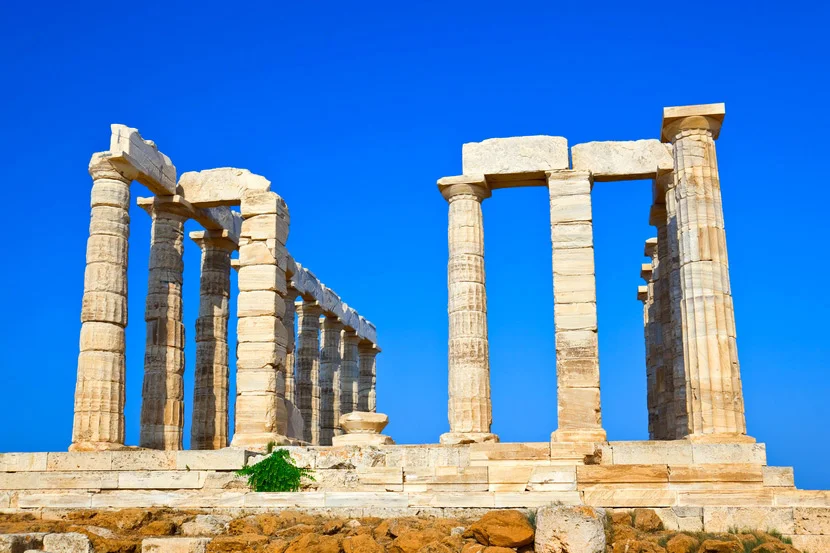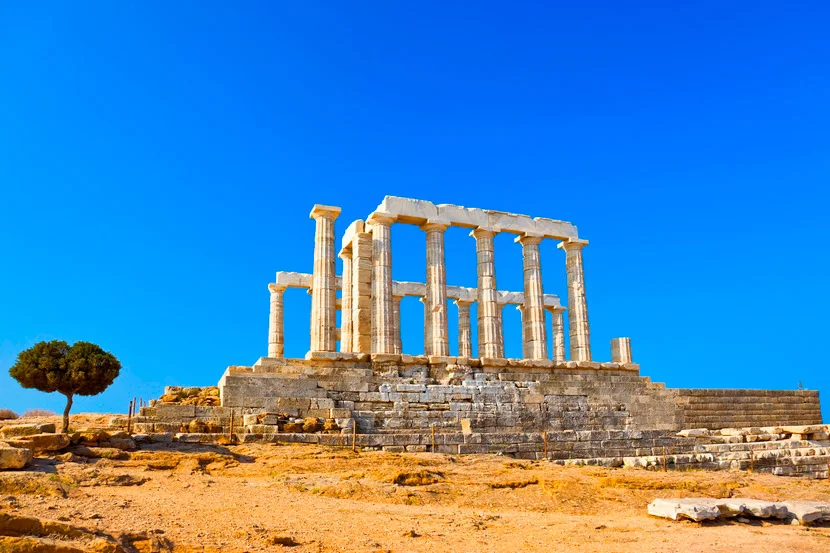 |
Temple of Poseidon (Sounion, Greece) Most tourists vacationing in Athens try not to miss the opportunity to take an interesting trip by car, which can be rented quite easily in Greece, or by sightseeing bus, to the legendary Cape Sounion. This cape is located in the southern part of Attica and is famous for the ruins of the once majestic Temple of Poseidon.
Sounion has always been inhabited by fishermen who, entering the Aegean Sea, have never been left without a catch. And how could it be otherwise, because the sea lord Poseidon himself was merciful to them, whose temple was erected on a high cliff right by the sea.
 |
| Temple of Poseidon Sounion |
At the moment, the road from Athens to Cape Sounion, thanks to the tourism and entertainment infrastructure developed in Greece, gives the traveler the opportunity not only to enjoy the scenic views, but also to rest on the way on one of the magnificent Greek beaches. You can often find various restaurants and bars along the road: these are not just roadside eateries, in any of them all the splendor of its national cuisine is offered to the guests of the sunny country. The end point of the path is Cape Sounion and, of course, the ruins of the Temple of Poseidon, striking in their size.
 |
| Temple of Poseidon Sounion |
A bit of mythology
As is known from Greek myths, the god Zeus decided, together with his brothers, to kill his father, who reigns supreme over all the elements. He did not become like Kronos and shared power with Poseidon and Hades. Poseidon, whose temple ruins are now located at Cape Sounion, Zeus gave power over the sea element. It is worth noting that the life of the Greeks has always been completely connected with the sea, it would be more correct to say that without it they could not imagine their existence.
 |
| Temple of Poseidon Sounion |
They were engaged in fishing and traded with other states, the way to which lay across the sea. Naturally, all this left a certain imprint on their ancient religion: the god Poseidon for the Greeks who lived even before our era was the second most important after the Thunderer. To go out to sea and not to offer Poseidon a sacrifice without asking for his protection, not a single fisherman or merchant would dare. A god who was angry with self-respect would certainly punish such a person, and the raging elements would surely destroy the ship along with its owner.
 |
| Temple of Poseidon Sounion |
Such was the god Poseidon, who bestowed good luck on some during fishing and sea travel, and punished others mercilessly. In addition to sacrifices and offering prayers to Poseidon, in order to appease the god of the sea, the Greeks erected a sanctuary for him, and after its destruction, a temple. Almost every Greek myth mentions that any gods, even the terrible Hades, who ruled over the kingdom of the dead, despite his immortality, the ability to command the elements and great power, experienced the same feelings as an ordinary person. They could love and hate, rejoice at gifts and be offended for showing disrespect to themselves. Therefore, sacrifices, gifts, the construction of temples and sanctuaries to the gods were an integral part of the life of the ancient Greeks.
 |
| Temple of Poseidon Sounion |
Another myth associated with Cape Sounion, where you can wander among the ruins of the ancient temple of Poseidon, concerns the very name of the Aegean Sea. It was from the cliff where the ruins are located that the inconsolable king Aegeus rushed into the sea, seeing the ship returning from the island of Crete. This ship was sailing at full speed under a black sail, on it the son of the king was supposed to return after the battle with the formidable and insidious Minotaur, who lives in a huge labyrinth. The son survived and defeated the monster, however, overwhelmed with joy in a hurry, he forgot to change the sail. Aegeus did not wait for the story of how his son "died" and, having decided to commit suicide, threw himself into the seething sea element. It is for this reason, as stated in the myths and legends of Greece, that the sea was named Aegean.
 |
| Temple of Poseidon Sounion |
Ruins of the Temple of Poseidon
Only the ruins of the Temple of Poseidon and twelve magnificent columns have survived to this day . The size of the colonnade is impressive: 13.47 x 31.12 meters. A tourist can also see parts of the architrave, which depicts Theseus fighting a bull and the centaurs, who entered into a fierce battle with the lapiths. This is all that is left on the rock, from which the most picturesque, one might say, even somewhat fantastic, view of the Aegean Sea opens up. Alas, it could not be otherwise, the inexorable passage of time did its job.
 |
| Temple of Poseidon Sounion |
According to some sources that have survived to this day, historians claim that the temple was built back in 440 BC. It is believed that the magnificent building was erected by the same architect who developed the plans for the sanctuaries of Nemesis and Hephaestus. In fairness, it should be said that these data are not confirmed by any evidence and are recognized by historians as only a legend.
 |
| Temple of Poseidon Sounion |
Until 480, on the site of the Temple, an equally magnificent structure rose, which the Greeks called the sanctuary of Poseidon, but the building where rituals were carried out and sacrifices were made to the god of the sea did not last long (just over 10 years), and was destroyed as a result of the invasion of the Persians. The Greeks constantly visited the Temple of Poseidon and prayed there to the god of the sea for mercy until the 1st century AD. A guide conducting excursions in Greece, telling about its historical, cultural and sights, will surely tell tourists that during archaeological excavations at Cape Sounion, a huge statue of a man was found, which is currently available for inspection in the Archaeological Museum of Athens. In addition, among the ruins of the temple, several small figurines were found, and even decorative elements that were previously inside the Temple of Poseidon.
 |
| Temple of Poseidon Sounion |
Temple of Poseidon - an unconventional view
Among some historians and enthusiasts trying to find evidence of the existence of the Atlantean civilization on our planet in the distant past, there is an opinion that the Temple of Poseidon was built by the inhabitants of the mysterious Atlantis , and not by the Greeks, as is commonly believed. In support of their version, they point to the fact that the architectural style of the temple at Cape Sounion is completely different from the style in which the Greeks built their sanctuaries in ancient times. Moreover, the description of the Temple of Poseidon by Plato has survived to this day. In it, he says that this building was so majestic and unique that a person could be speechless from the splendor he saw.
 |
| Temple of Poseidon Sounion |
All the walls of the temple, according to Plato's description, were decorated with gold and silver, and in its courtyard there was a garden, consisting of strange giant trees. Near the Temple of Poseidon itself, there was a huge number of majestic sculptures cast in gold. These sculptures were supposed to immortalize the names of the kings and their wives. In the writings of Plato, you can find a description of the interior decoration of the temple: "All the walls were decorated with gold, and the ceiling was trimmed with ivory, in the middle of a huge hall there was a statue of Poseidon on a chariot, he was surrounded by a hundred beautiful nymphs floating on dolphins." “The Greeks could not have erected such a building in 440 BC, and it was most likely the Atlantean temple,” says one of the historians in his report. Right or wrong, at the moment no one can answer in the affirmative. No evidence to support this version.
 |
| Temple of Poseidon Sounion |
Temple of Poseidon at Cape Sounion - a memo for the tourist
Everyone who has ever seen the Aegean Sea from the cliff, where the ruins of the Temple of Poseidon are located, strongly recommend that friends and acquaintances visit this interesting and mystical place, which is associated with so many legends. The huge Doric columns, built 440 years before the coming of the Savior to our world, make a truly stunning impression. Tourists can admire the Temple of Poseidon from the first days of April to October : the entrance is open from 8-30 am to 8 pm. Access to the monument of the history of Ancient Greece is paid: the ticket price is only 4 euros. Children and adolescents, students who are under 18 years of age can visit the Temple of Poseidon completely free of charge, however, for this they must live in one of the countries of the European Union.